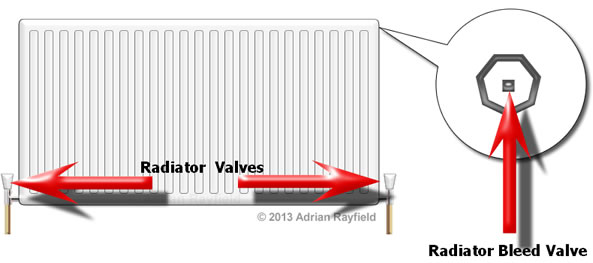Painting, decorating and home improvement tips blog
How to bleed a radiator
Posted by Adrian
February 11th, 2020
How to bleed a radiator
If you have central heating and radiators you will from time to time need to bleed them. This basically means allowing any build up of air out of the system and allow that space to be filled with water.
If you do not bleed the system you will get cold areas within the radiator and the system will not be as efficient and you will not be getting the full heat out of the system.
How can I tell if I need to bleed my radiators
You can tell if you need to bleed your radiators simply by feeling them once they have been on for a while, the radiator will feel cooler at the top than the bottom, mostly the air will be at the top of the radiators, but you may feel cooler spots lower down also. If you find cooler areas more than likely this will be air which doesn’t get as hot as the water so therefore is cooler. If this is what you find, bleed the radiators.

How do I bleed my radiators
This is a quick and easy job, firstly open up all the radiator valves fully, including thermostatic ones, then run the system for around 10 minutes and then turn the system off. You will then need a radiator bleed valve key and a cloth. If you haven’t got a bleed valve key, they can be bought cheaply at a hardware store.
Go around all radiators and open slightly the bleed valve by turning anti-clockwise, this will be located at the top of each radiator and on one edge. Depending on the age of the radiator you may have a small plastic end over the bleed valve, this will direct the water away from the wall. Make sure this is facing away from the wall if not turn it so that it is, you could aim it into a bucket before opening the bleed valve.

Carefully open the valve slightly with the valve key, air should then come out, keep the valve open until water comes out then shut the valve by turning clockwise. Hold the cloth around the bleed valve as you do this to catch any water.
Once you have done this to all radiators you may have to check the pressure of the boiler by looking at the gauge, if the pressure has dropped you may have to ‘top up’ the pressure. This is normally done by opening a tap on the boiler until the correct pressure is reached. To top up the boiler open the tap on the filling Loop, check the boiler handbook to find out how to do this.
If you find that after you have bled the radiators the radiators nearer the boiler are hotter than those furthest away, this means the radiators aren’t balanced and you may have to turn the valves down on the radiators near the boiler and leave the ones furthest away fully open, this will allow the water to reach the furthest away radiators before cooling down.

Top Tip : If the bottom of the radiators are cold, this could be due to a build up of sludge and rust, this needs solving by draining the system down and flushing it all through. If you are unsure call a plumber / heating engineer.
Tags: Bleed, Boiler, Central Heating, DIY, Handyman, heating, Plumbing, Radiator, Valve
Posted in Home Improvements | No Comments »
How to paint a radiator
Posted by Adrian
March 1st, 2010

How to paint a radiator
To paint a radiator firstly turn it off and let it go cold if it has been in use. Once the radiator is cool your ready to begin.
Firstly give the old paint on the radiator a ‘key’ for the new paint to adhere to, basically this means give the radiator a light rub down with a fine to medium grit abrasive such as sand or glass paper. You could also use wet and dry.
Next, dust off the radiator or wipe it over with a damp cloth to remove and dust. You are now ready to start painting.
It is advisable to lay a dustsheet under the radiator to catch any spills, splashes etc.
Where to start?
I normally paint the ends first, painting around the bleed valve end then the other end.
Load the brush with paint and paint the first three or four flutes (the indented parts) at the top and the bottom ensuring they are covered well.
Next paint the first few flutes from top to bottom, then with an unloaded brush, brush from top to bottom spreading the paint over evenly.
Depending on how big the radiator is you can paint all the flutes and then the top and bottom of the radiator. If the radiator is big or if you work slowly it is better to do a few flutes and then work the top and bottom along as you go.
When you have worked your way along the entire length of the radiator go back and check for any runs, normally at the bottom of the flutes, if there are any runs simply brush them out with an unloaded brush.
Finally, stand back and admire your work!
Please note that when you do turn the radiator on again it will give off a smell, this is the paint and is normal, the smell will go after the radiator has been on a few times and the paint is fully cured.
Tags: Paint, Radiator
Posted in Decorating Tips | 3 Comments »
